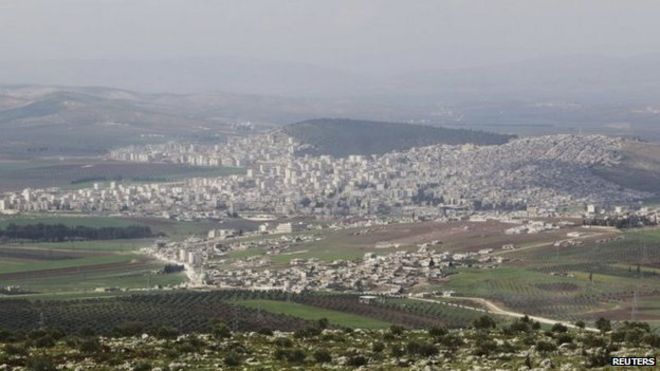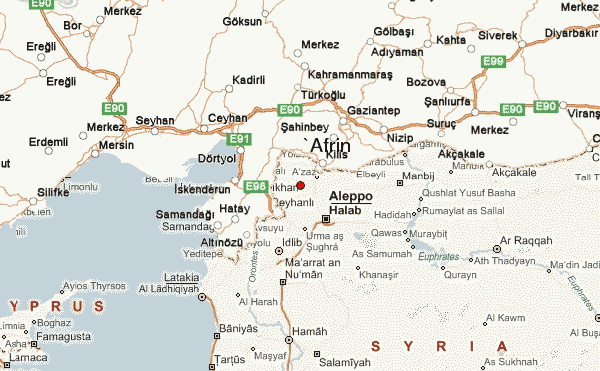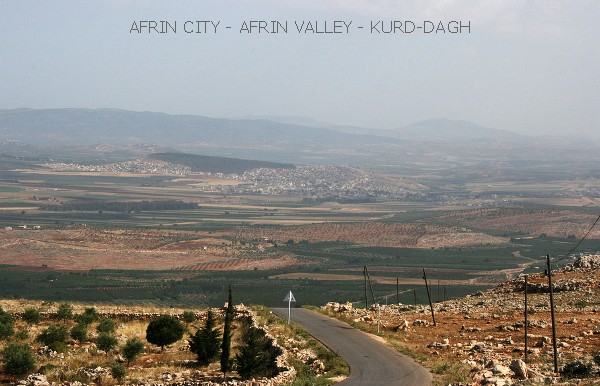Afrin, Syria
Government
Afrin (Arabic عفرين, DMG ʿ Afrin, Kurdish: Efrin or Afrin ) is the name for both a district in the province of Aleppo in Syria, and for the same capital.
Afrin city
The current market center Afrin is a start-up of the 19th century. The population in 1929 was 800, rising to 1968 to about 7,000. For 2003, 44 121 inhabitants indicated. Afrin is on two different roads every 55 kilometers northeast of Aleppo in the wide valley of Afrin, on the lead two bridges within the town. The central square is the bus stop for minibuses, the old residential area stretches across the north of it rising hill.
District Afrin
The district borders the south of the Turkish province of Kilis and east to the Turkish province of Hatay (Kurdish Xetayê the geographical name for the country south-west of the Euphrates ). The district includes the Kurd Dagh region Afrin ( Çiyayê Kurd yan Kurmanc, Arabic جبل الاكراد Jabal al - Akrad, Mountain of the Kurds "or" Kurds mountain '), which extends west to the Turkish border and in the south and east by the river Afrin is limited, the district extends in that direction over the river. Afrin has an area of 2033 km ² and consists of seven municipalities: the city of Afrin in the center, Jindêrês, Scharan, Mobetan / Mahbatli, Rajo, Bulbul, Maydana and Schiyê, with a total of 366 villages or hamlets such as Katma, Kastall, Qîbar and Rajo. The name means Afrin in Kurdish " ( blessed ) creation." To say that you come from Afrin, is in the area around Aleppo verklausulierte form to express that it is Kurdish.
Population
In 2000 lived in the district Afrin according to two different sources about 200,000 or 450,000 people. Although the Syrian government encouraged the settlement of Arabs since the 1970s, the Kurds continue to form the majority. There are also some scattered Bedouin Arabs living and Roma. In the early 1920s many Kurds fled from the southeast of Turkey into the previously populated by Kurdish region. Many residents Afrins now live abroad. Due to the high unemployment and rural exodus fled in recent decades, many Kurds in the cities of Aleppo and Damascus, where they partially settled in the slums.
Most of the inhabitants in the region Afrin are Sunni Muslims. There are about 7500-10000 Yazidis, which are called here Zawaštrī. Just a few centuries more Kurds known for Jesidentum than today. There are also a few Kurdish Alevi villages.
At several remote locations in the region, there are pilgrimage sites, which are visited mostly by Sunnis, but also of other religious communities, with the exception of the Yazidis. The most famous sacred place in popular belief is Nebi Houri. Another local Islamic saint is known Sayḩ Rashid, whose tomb ( Qubba ) is as Ziyarat Hanan ( Ziyarat, " pilgrimages to holy shrines " ) and is located seven kilometers north-east of Afrin on a hill.
Language
Kurds in the region Afrin speak Kurmanji, the main dialect of the Kurdish language. Due to some regional peculiarities of their dialect is (ie Afrinisch ) called within the Western dialect of Kurmanji also Efrînî. Characteristic of the Afrini the pronunciation of û as above, the e as a and a is as ɔ: . In addition, hot "she" and "he" (3rd person, singular and plural) not only " ewan, wana, WI, WE" but also " gendio " or " gêndih ". " Gêndih " (plural: " Gêndiyan " ) is only used in the nominative case and most often used as a polite form. The dialect is also spoken Afrini in the regions Antep and Urfa.
Climate
There is a dry Mediterranean climate, with annual rainfall of about 400 to 500 millimeters predominantly in the winter months. In dry years, the rain is sufficient for the cultivation of winter crops, summer crops require irrigation. The average temperature in January is 6-10 ° C. In the winter months snow can fall, but temperatures below freezing are rare. The average maximum temperature in July and August is 30-33 ° C.
Agriculture
In the Afrin Valley is operated on deep red soils and irrigation through diesel pump from the groundwater intensive agriculture, there are mainly wheat, cotton, citrus fruits, pomegranates, melons, grapes and figs planted. The staple crop in the region olive trees, of which there should be more than 13 million in Afrin. This also thrive in part, on the adjacent rocky hills of the northern Syrian basalt plateau, which is often covered only by a thin layer of soil. On unbewässertem land winter wheat is grown mostly (wheat or barley).
Livestock in small stables at the house is operated for its own purposes or for the local market. In the villages, yoghurt (Arabic live ) and cheese ( lebne ) in their own home made .
History
Eight kilometers south of the town Afrin is the late Hittite settlement mound of Tell Ain Dara from the 10th to the 8th century BC, the time of the Ottoman Empire, the Afrin region belonged to the former Kurdish province of Kilis, which is now in Turkey. After the border agreement between France and Turkey in the 1920s came Afrin, which had heard before the Ottoman province of Kilis, first the League of Nations Mandate for Syria and Lebanon, from which 1946 independent Syria emerged.
On March 21, 1986 saw riots by Kurds against the government, in which police killed three people during a Nowruz celebration, including a young girl. In 1999, the chairman of the Kurdistan Workers' Party (PKK ) Abdullah Ocalan was arrested, there were clashes and riots between applied youth and the police.
Sons and daughters of the town
- Joseph Bakir (born 1971 ), Syrian painter
- Kamal Sido ( b. 1961 ), historian
- Xelîl Xemgîn, singer
- Bangin, singer










